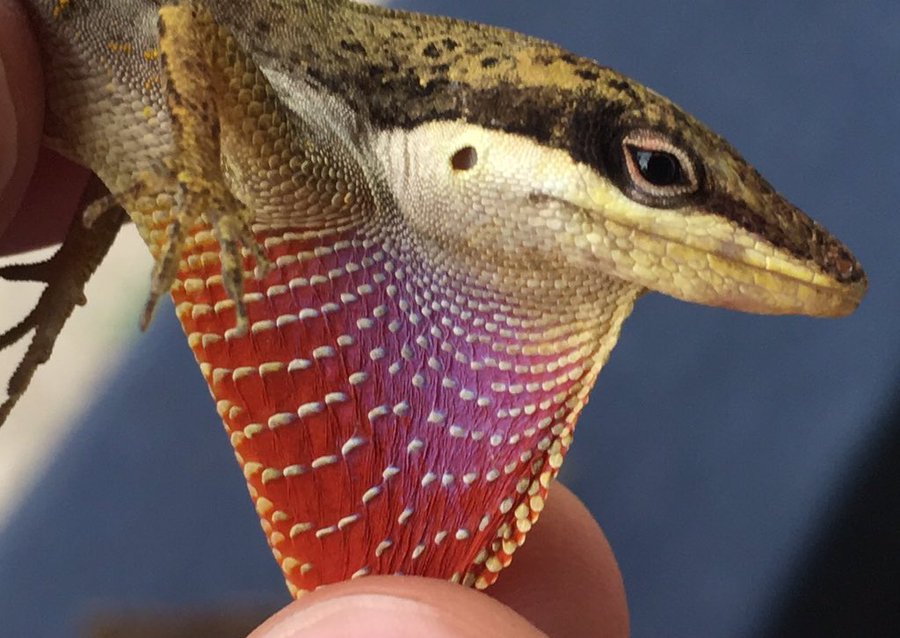Cities are hot. Because of the urban heat island effect, urban environments tend to be significantly warmer than nearby non-urban environments. For ectothermic organisms, like lizards and insects, elevated urban temperatures create thermally stressful conditions. It might be unsurprising then that researchers have documented an increase in thermal tolerance in urban animals (e.g., City Ants Adapt to Hotter Environment). These studies point to the ability to cope with elevated urban temperatures as a critical aspect of persisting in urban environments.
Although there is evidence that the urban environment shapes adaptive thermal tolerance in Anolis lizards at the genomic level, it is also possible that anole species that thrive in hot urban environments have an innate ability to do so due to local adaptation in their ancestral habitat (i.e., forests). In fact, an analysis of patterns of urban tolerance across Caribbean anoles found that species that experience hotter and drier temperatures in their native ranges and those that maintain higher field body temperatures tended to be the ones that do well in urban environments (Winchell et al. 2020). And when researchers looked at genomic variation in Cuban species not found in urban areas, they identified genes associated with thermal sensitivity (Akashi et al. 2016), suggesting tolerance of different thermal environments may be encoded at the genomic level. But does this mean that some anoles are predisposed to tolerate hot urban temperatures based on the climate of their ancestral forest homes?
Kanamori et al. (2021) — “Detection of genes positively selected in Cuban Anolis lizards that naturally inhabit hot and open areas and currently thrive in urban areas” — set out to answer this question by examining the transcriptome of nine species of Cuban anoles that occupy different thermal microhabitats. Cuba is home to the largest number of anole species, with species diversifying to occupy distinct thermal and structural microhabitats. In their study, the researchers attempted to identify genomic signatures of selection in non-urban populations of species that thrive in urban environments in order to understand if there was something unique about the genetic background related to thermal tolerance in these species that enables urban colonization.
Of the nine species Kanamori and colleagues studied, three are found in naturally hot and open environments: A. allisoni, A. porcatus, and A. sagrei, representing two different branches of the Cuban anole radiation. These three species (and several of their close relatives) also thrive in urban environments both in Cuba (e.g., Havana) and in their non-native range (e.g., Miami, Florida).

Anolis allisoni, Photo by Juan Rafael Rodríguez
iNaturalist
Five other species are found in cool and deeply shaded forests: A. alutaceus, A. isolepis, A. garridoi, A. allogus, and A. mestrei. The last species, A. homolechis, is common in the shaded areas of forest margins.

Anolis alutaceus, Photo by Yasel U. Alfonso
iNaturalist
Kanamori and colleagues examined a total of 5,962 genes and found genomic signatures of selection in 21 genes in the two main branches of species that contain urbanophilic species (A. porcatus & A. allisoni, and A. sagrei), but did not identify selection in the same genes across the two lineages. In other words, these closely related species have found unique genomic pathways to deal with the hot and dry forest environments in which they thrive. This finding suggests that the predisposition to tolerate hot urban environments is determined by different genes in different anole species, and raises the possibility that further local adaptation to urban thermal environments may also be lineage specific.
When the researchers looked at the functional associations of the genes under selection in each species, they found that they were related to stress responses, epidermal tolerance to desiccation, and cardiac function. All three of these biological functions are implicated in maintaining appropriate acclimation responses to thermal stress in anoles. These findings implicate ancestral selection on stress responses, perhaps in response to thermal or ultraviolet radiation, as potential factors influencing tolerance of anoles in urban environments. Further exploring the importance of these functions will shed light on their role in the initial tolerance of urban environments upon urban colonization and adaptive modification as urban lineages persist.
Read the full paper here:
Kanamori, S., Cádiz, A., Díaz, L.M., Ishii, Y., Nakayama, T. and Kawata, M., 2021. Detection of genes positively selected in Cuban Anolis lizards that naturally inhabit hot and open areas and currently thrive in urban areas. Ecology and Evolution, 11(4), pp.1719-1728.
This post was cross-posted on the blog “Life in the City” — check it out if you want to learn more about urban evolution!




















![Anolis landestoyi (2 of 2) [image] | EurekAlert! Science News](https://i0.wp.com/www.eurekalert.org/multimedia/pub/web/117940_web.jpg?w=629&ssl=1)









